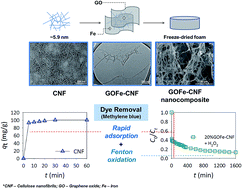Bifunctional graphene oxide–cellulose nanofibril aerogel loaded with Fe(iii) for the removal of cationic dye via simultaneous adsorption and Fenton oxidation†
Abstract
A highly porous cellulose nanofibril (CNF) aerogel loaded with graphene oxide–iron(III) (GO–Fe) nanocomposites was produced and used for the treatment of methylene blue (MB) in aqueous solution. The CNF aerogel serves as an adsorbent for the dye, while the GO–Fe nanocomposites play a role in the decomposition of the dye via the Fenton oxidation reaction. The aerogel exhibits rapid adsorption performance (less than 10 min) for removing MB, with a maximum adsorption capacity of 142.3 mg g−1. On the side of enhancing the MB removal, the GO in the GO–CNF nanocomposite aerogel was loaded with 1 wt% of Fe(III) to perform as a catalyst for the Fenton oxidation reaction. The MB continues to decolorize by 30.4% more after 24 h of the reaction process. Moreover, by performing Fenton oxidation for adsorbent regeneration, the adsorption capacity for nanocomposite adsorption was reduced by 52.2% after five cycles of adsorption–oxidation.


 Please wait while we load your content...
Please wait while we load your content...